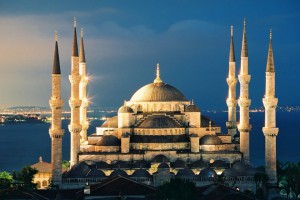From the legends of Troy to ancient Greek cities, your travels will reveal the places where history happened. On this in-depth Best of Turkey voyage, you’ll also venture into the Taurus Mountains for lunch with the Yazir community and relax on the shores of the Turkish Riviera.
Ankara
Ankara
Turkey's capital is a sprawling urban mass in the midst of the Central Anatolian steppe. Since 1920 when Ataurk set up his provisional government here, Ankara's main business has been government but several significant attractions make it worth a short visit. Most visitors head straight for Hisar, the Byzantine citadel atop the hill east of the old city, and the nearby Museum of Anatolian Civilizations. To the south is Ataturk's mausoleum, a monumental building, spare but beautiful, that echoes the architecture of several great Anatolian empires. The Presidential Mansion is preserved as Ataturk used it, with decor and furnishings of the 1930s, including billiard table and cigar-and-brandy nook. There's a lot of ancient history around too. Roman Ankara was a city of some importance, and Roman ruins are dotted in amongst the mosques and monuments of Muslim Anatolia.
|
Destination Guide
|
Goreme
Goreme
The small town of Goreme is situated in the middle of the Valley of Fairy Chimneys, surrounded by the eerie shapes and fantastic rock formations that have made the region famous. It is one of the few remaining villages where fairy chimneys and rock-hewn houses are still inhabited, and several pensions, restaurants and cafes are carved into the rock. Its biggest attraction is the Goreme Open-Air museum with over 30 beautifully frescoed Byzantine rock churches. The town makes an excellent base from which to explore the surrounding rock formations, villages, vineyards and attractions. For shoppers, carpets and kilims are plentiful.
|
|
Cappadocia
Cappadocia
The underground cities of Cappadocia give you an idea of the sensation of what living in a labyrinth felt like. Derinkuyu is one of the 40 subterranean settlements in this area. It was at one time the home for up to 20,000 people. Its 18 stories descend into the Anatolian plateau south of Goreme. The ventilation shafts, circular and descending from the surface to the lower levels, and the massive circular doors remind you of the motivation for moving underground in the first place – to guarantee a degree of protection. There are eight floors of tunnels open to the visitor. Not for the claustrophobic.
|
Destination Guide
|
Konya
Konya
Ivriz is a relief representing a king and fertility god of the Hittite period. Eflatun Pinar is a holy Hittie monument fountain. A Byzantine church and several rock chapels can be seen in Sille, where the first rock carved monasteries of the world were built. During the 12th and 13th centuries, Konya acted as capital of Seljuk Turks and advanced rapidly to become a cultural center. The most famous building is the Green Mausoleum of Mevlana Celaleddin Rumi, now a museum housing Mevlana's works. Alaeddin Hill's mosque and palace are fine 13th century monuments built during the reign of the famous Seljuk Sultan. Karatay Medresse is a museum holding the best examples of Seljuk tiles and ceramics. The Ince Minareli Medresse, the Sircali Medresse, and the Iplikci Mosque are other Seljuk works. The various museums housing historical finds are other interesting sights. The Archaeological Museum should be visited for its charming pieces. The Koyunoglu Museum, with Izzettin Koyunoglu House, is beautiful; the Ethnographical Museum and Ataturk's House are for history lovers.
|
Destination Guide
|
Antalya
Antalya
This sun-drenched Mediterranean town on the Turkish Riviera is a major resort with a beautiful crescent bay, dramatic cliffs, and jagged mountains. It is an attractive city with shady palm-lined boulevards and a prize-winning marina. In picturesque old quarter, narrow streets and old wooden houses huddle against ancient city walls. Antalya's visitors come see the old town with its picturesque harbor and excellent Archaeological Museum. Its outstanding exhibits provide fascinating glimpses into the life of the region. In the surrounding area are additional attractions such as Aspendos, Perge and Side. Their remains of antiquity are considered among the most impressive sites. Visit Hadrian's Gate and Main Square, which with its landmark clock tower offers views of the bay and distant mountain peaks. Karatay Medrese (Theological College) exemplifies the best of Seljuk stone carving. Ataturk Museum features a collection of interesting memorabilia commemorating the founder of Turkey.
|
Destination Guide
|
Pamukkale
Pamukkale
One of the most interesting geological sites in Turkey is in the town of Pamukkale, the "cotton castle" of terraced pools caused by cascading calcium rich mineral springs. From the edge of every terrace and every step in this fascinating natural phenomenon that has gradually formed throughout the ages hang brilliantly white stalactites, and you can hear the joyful splashing of the waters of the hot springs as they cascade down over slopes where their flow is impeded only by clumps of oleanders. You can also visit the ancient ruins of Hieropolis here, an interesting archaeological site.
|
Destination Guide
|
Izmir
Izmir
Izmir is a major seaport in western Turkey, on the Aegean Sea and is the gateway to Ephesus and Sardis. Ephesus is one of the ancient world's largest and most important archaeological and religious sites. Some of the site's most significant structures included the Temple of Artemis, one of the Seven Wonders of the Ancient World, the Basilica of St. John, where the Apostle is buried and the House of the Virgin Mary. Other highlights include the Great Amphi-theatre where St Paul was arrested, Kuretes Street and the Library of Celsus. Sardis was an ancient city of Asia Minor, and the recently uncovered remains lie to the north-east of Izmir. The city attained its greatest prosperity during the reign of Croesus, king of Lydia, and after his overthrow in 546 BC by Cyrus the Great of Persia, it became the western capital of the Persian Empire.
|
Destination Guide
|
Canakkale
Canakkale
On the Asian shore, guarding the Dardanelles, is the quiet Turkish port town of Canakkale. History enthusiasts will want to venture to legendary Troy. Canakkale's Archaeological Museum boasts exhibits originally belonging to Frank Calvert, aide to the discoverer of the lost city, Heinrich Schliemann. Visit the vast memorial at Galipoli Peninsula, site of the notorious World War I campaign. Be sure to sample the culinary delights of a meze, a spectacular array of Turkish hors d'oeuvres.
|
|
Istanbul
Istanbul
This centuries old capital guards the slender waterway between the Mediterranean and the Black Sea, and is the doorway between the East and West. Visitors can explore remnants of Byzantine Constantinople in the Sultanahmet district, where you will have the chance to see ancient splendors, such as the Haghia Sophia, the Blue Mosque and Topkapi Palace. At night the city boast a lively nightclub scene and excellent Turkish dining options that may include cultural entertainment and dancing. Istanbul also features splendid shopping malls, boutiques, and hand crafted items can be found all over the city.
|
Destination Guide
|






